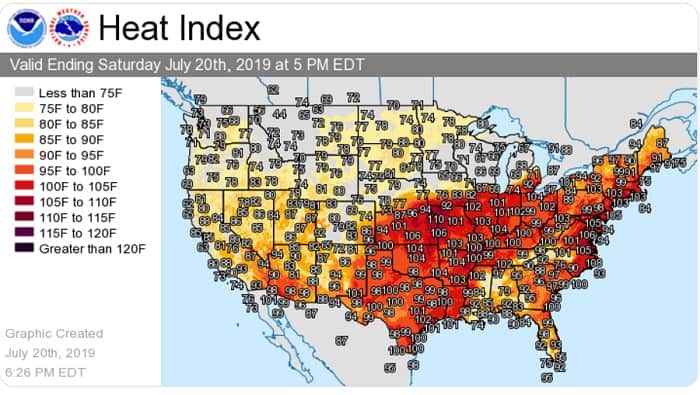Post Heat Wave Reflections

The recent heat wave was a hot one. Naturally, progressive commentary “linked” it to climate change. The linkage almost seems tautological. How could rising global average temperatures not increase the frequency and intensity of heat waves? Surprisingly, the expected greenhouse “fingerprint” or climate change “signal” in U.S. summer temperature data remains elusive.
On Saturday, July 20th, the “heat index” in Washington, D.C. peaked at 106°F. As explained by the National Weather Service, the “Heat Index is a measure of how hot it really feels when relative humidity is factored in with the actual air temperature. . . . As an example, if the air temperature is 96°F and the relative humidity is 65 percent, the heat index—how hot it feels—is 121°F.”
Here is NWS’s Heat Index map of the continental United States for last Saturday:

On the following Monday, WMAL radio talk show host Chris Plante noted that on July 20th in 1930, the temperature in Washington, D.C. hit 106°F. That was decades before the rapid postwar rise in atmospheric carbon dioxide concentrations. In those days, moreover, weather services reported just the temperatures measured by thermometers without upward adjustment for relative humidity.
In a column published Tuesday, environmental researcher Steve Goreham rebuts claims by public health organizations that fossil-fuel combustion is causing “extreme heat, powerful storms and floods, year-round wildfires, droughts, and other climate-related events.” Goreham provides historical perspective on the recent heat wave:
History shows that the warmest US decade on record was the 1930s, long before industry emitted significant amounts of carbon dioxide. According to the National Oceanic and Atmospheric Administration (NOAA), 23 of the 50 state record high temperatures were recorded during the 1930s. Thirty-six of the 50 state record highs occurred prior to 1960.

Last week, temperatures in Iowa, Illinois, Indiana, Ohio, and Pennsylvania peaked at about 100 degrees Fahrenheit. But these temperatures were far below the state record highs, which were Iowa (118oF in 1934), Illinois (117oF in 1954), Indiana (116oF in 1936), Ohio (113oF in 1934), and Pennsylvania (111oF in 1936).
The recent heat wave affected an estimated 200 million people, and six people died. But heat waves are far from the greatest risk factor Americans face in their daily lives. The Centers for Disease Control estimate 8,081 heat-related deaths were reported in the United States during 1999-2010. That works out to 735 deaths per year. In contrast, 37,461 Americans died from automobile accidents in 2016, and 80,000 Americans died from the flu and its complications in 2017.
The good news is that since the 1960s, heat-related mortality rates in the United States and other developed countries have declined. Moreover, globally, the individual risk of dying from all forms of extreme weather has declined by 99 percent since the 1920s. That is chiefly due to wealth creation and technological advances supported by mankind’s increasing utilization of fossil energy.
Chilling economic growth by taxing and regulating away humanity’s access to fossil energy will not help societies mitigate existing climate-related risks or adapt to a changing climate, but more likely hamper the ongoing progress of the past 100 years.